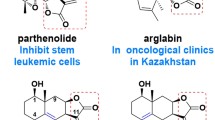Abstract
For the evaluation of the role of α,β-unsaturated ketone portion of ar-turmerone for its activity, the structural variation of this structural unit was performed to omit its alkylating property. Thus compounds2, 3, and4 were prepared and their cytotoxicities were determined against three different leukemia cell lines (HL-60, K-562, and L1210)in vitro. The biological inactivity against three different cell lines of these analogues implies that the α,β-unsaturated ketone of ar-turmerone is the essential pharmacophore for its activity.
Similar content being viewed by others
References Cited
Ahn, B. Z. and Lee, J. H., Cytotoxic and cytotoxicity-potentiating effects of the curcuma root on L1210 cell.Korean J. Pharmacognosy, 20, 223–226 (1989).
Breitner, E., Rogniski, E., Rylander, P. N., Low pressure hydrogenation of ketone with platinum metal catalysts.J. Org. Chem., 24, 1855–1857 (1959).
Greenwald R., Chaykovsky, M., Corey, E. J., The Wittig reaction using methylsulfenyl carbaion-dimethylsulf-oxide.J. Org. Chem., 28, 1128–1129 (1963).
Honwad, V. K. and Rao, A. S., Absolute configuration of ar-turmerone.Tetrahedron, 20, 2921–2925 (1964).
Itokawa, H., Hirayamo, F., Funakoshi, K., and Takeya, K., Studies on the antitumor bisabolane sesquiterpenoids isolated from Curcuma xanthorriza.Chem. Pharm. Bull., 33, 3488–3492 (1985).
Kraus, G. A., Frazier, K., Selective reduction via enolate protection.J. Org. Chem., 45, 4262–4263 (1980).
Lee, J. H., Kang, S. K., and Ahn, B. Z., Antineoplastic natural products and the analogues(XI)-Cytotoxic activity against L1210 cell of some raw drugs from the oriental medicine and falklore.Korean J. Pharmacognosy, 17, 286–291 (1986).
Matthes, H. W. D., Luu, B., and Ourisson, G., Cytotoxic components ofZingiber zerumbet, Curcuma zedoaria, andCurcuma domestica.Phytochemistry, 19, 2643–2650 (1980).
Oh, W. G., Baik, K. U., Jung, S. H. Ahn, B. Z., The role of substituents of ar-turmerone for its anticancer activity.Arch. Pharm. Res., 15, 256–262 (1992).
Perrin, D. D. and Armarego, W. L. F.,Purification of Laboratory Chemicals, 3rd Edition, Pergamon, Oxford, 1988, pp. 65–309.
Rupe, V. K. and Wiederkehr, F., Zur kennites des arturmerone aus dem cucuma-ol.Helv. Chim. Acta, 7, 654–656 (1924).
Thayer, P. S., Himmerlfarb, P. and Watts, G. L., Cytotoxicity assay with L1210 cellin vitro, Comparison with L1210 in vitro and KB cellsin vitro.Cancer Chem. Rep., 2, 1–25 (1971).
Author information
Authors and Affiliations
Rights and permissions
About this article
Cite this article
Baik, KU., Jung, SH. & Ahn, BZ. Recognition of pharmacophore of ar-turmerone for its anticancer activity. Arch. Pharm. Res. 16, 254–256 (1993). https://doi.org/10.1007/BF02974492
Received:
Issue Date:
DOI: https://doi.org/10.1007/BF02974492




